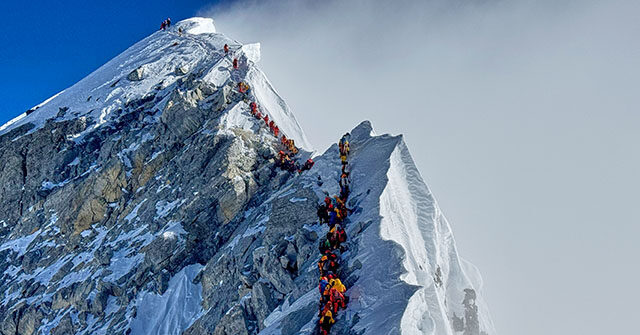A huge blizzard swept the slopes of Mount Everest over the weekend, trapping hundreds of climbers and forcing rescue workers to conduct high-altitude evacuations.
The timing of the blizzard was especially unfortunate because the fabled mountain was heavy with tourists during China’s National Day holiday.
The unexpected blizzard bathed the Himalayas with snow and rain on Friday and continued throughout the weekend. Conditions were especially harsh on the eastern face of Mount Everest, which lies in Chinese-occupied Tibet.
China’s six-day National Day holiday, which commemorates the founding of the communist People’s Republic of China by dictator Mao Zedong, began on Wednesday. The National Day holiday is always a big season for travel and tourism in China. According to Chinese state media, traffic at major tourist destinations was especially heavy this year.
The Chinese Communist government made a point of cracking down on native Tibetans, and other restless populations, in advance of National Day to facilitate tourism. Chinese dictator Xi Jinping paid a rare visit to Tibet in August to commemorate the 60th anniversary of its conquest. A major theme of Xi’s visit was how thoroughly Tibet has supposedly been integrated into Beijing’s empire, and how much the locals have benefited from that integration.
According to local officials, no climbers were trapped by the blizzard on the Nepalese side of Mount Everest. The Chinese side has been experiencing a surge of tourism ever since coronavirus restrictions were eased, while Nepal has been more cautious about permitting expeditions. Some Nepalis complain their government has been too stingy about allowing climbers, depriving Nepal of much-needed tourist revenue, while some climbing experts fear the Chinese side has become dangerously overcrowded.
Those fears seemed to come true on Friday, when up to a thousand climbers were reportedly stranded at various points on Everest due to the sudden blizzard conditions. Some of the climbers were trapped at elevations above 16,000 feet. Mount Everest is 29,000 feet high at its peak.
On Sunday, rescue workers said they were in contact with about two hundred hikers who were still trapped at high altitudes. 350 more had been recovered and escorted to a rally point in China’s Tingri county. The exact number of stranded climbers was not known, but early estimates ranged as high as one thousand.
Hundreds of rescue workers were involved in the massive recovery effort, supported by villagers in the lower reaches of Everest who helped to shelter and feed the rescued climbers. Local villagers also pitched in with clearing snow away from blocked trails.
“It was so wet and cold in the mountains, and hypothermia was a real risk. The weather this year is not normal. The guide said he had never encountered such weather in October. And it happened all too suddenly,” said hiker Chen Geshuang, as quoted by Reuters.
Some other hikers interviewed by Reuters said they chose to head back down the mountain when the snow began to intensify, but they did not make it all the way down before crushing amounts of snow trapped them inside their tents, then caused the tents to collapse.
Several climbers were treated for hypothermia, but as of Monday afternoon, no fatalities were reported from Mount Everest. A South Korean hiker was killed by the blizzard while climbing the 21,246-foot Mera Peak in Nepal. His body was recovered by helicopter on Monday.
Read the full article here


